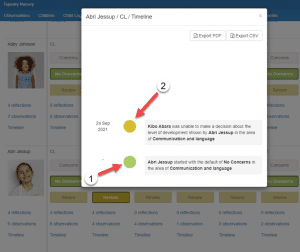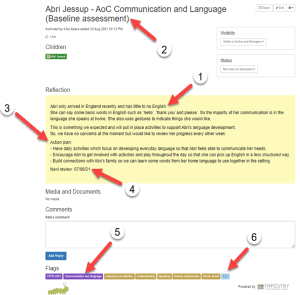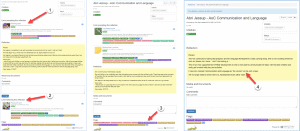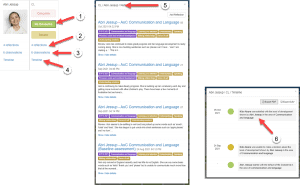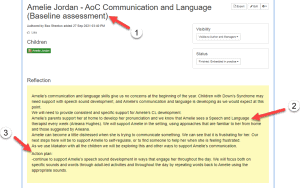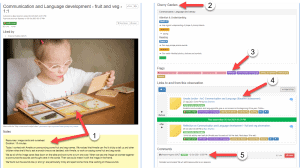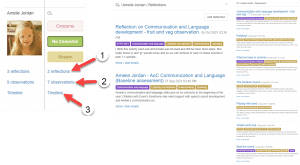Using Observations and Reflections with the Areas of Concern Screen
by Anya on November 30
5 min read:
This advisory article explores how you can use your observations and reflections with the Areas of Concern screen on Tapestry. It includes examples of this process and how it can assist you in supporting the learning and development of children in your setting.
Why might you mark a child as ‘Review’?
All children will start with the default of No Concerns on the Area of Concerns (AoC) screen.
As you can see in the image below, Abri’s Communication and Language (CL) was marked as Review on the 24/09/21. Abri had just arrived in England and hadn’t needed to learn English up until this point. Having spent time with Abri’s Mum, and observing Abri, I knew that her language development was as to be expected. Marking the AoC as ‘Review’ allowed me to show that, although I was not concerned, I still knew that regular reviews were needed until I could mark CL as either ‘Concern’ or ‘No Concern’.
At the time of marking CL as ‘Review’ I created a Reflection to explain why I’d done that (1). As this was the first Reflection I titled this as Baseline assessment (2).
I also added an Action Plan (3) so that both my colleagues and I knew what we needed to do in order to support her language development. Although Reflections aren’t visible to relatives, you can still share the action plan with relatives if you wish or if they are asking about the support you are planning to provide.
I added a date to next review Abri’s progress to ensure we were providing appropriate support (4).
I have attached EYFS 2021 flags (5) so that it links through to the AoC screen and also created my own Bespoke Flag for EAL (6) which allows me to filter the reflections by EAL.
Within some of these reflections I have linked the observations that prompted the reflection (1) and also linked observations after the reflection was made (2) to show the impact of the support being given in relation to the Action Plan.
Each time, I set an Action Plan and a date for the next review, to demonstrate that we are consistently monitoring Abri’s progress and we know what steps we have taken to facilitate and support Abri’s CL development.
I also made sure that I attached the EYFS 2021 flags each time so that they would feed into the AoC screen (3).
I then carried out a number of reviews via Reflections until I felt that I could mark Abri’s Communication and Language as ‘No Concern’ (4).
Back on the AoC screen I would mark Abri’s Communication and Language as ‘No Concern’. I was confident that she was accessing the provision from her starting point and that this was allowing her to make progress.
On the AoC (Group View) screen I can see that Abri’s CL is now marked as ‘No Concerns’ (1), I can also see the linked reflections (2) and observations (3) which have been linked because of the EYFS 2021 flags I added to each one. Finally, I am given the Timeline for CL (4). Clicking on ‘4 reflections’ will show me all of the reflections I have created (5). Clicking on the Timeline will show me exactly when Abri was marked as ‘Review’ and when I marked her CL development as ‘No Concerns’ (6).
I also know that, if any concerns do pop up then I can go back to the AoC screen and continue this process of reviewing Abri’s development through Reflections.
Why might you use observations and reflections when a child is marked as ‘No Concern’?
Fundamentally, it’s all about knowing the children in your setting and understanding their personal and learning needs. As mentioned previously, all children’s AoC timelines will start out as ‘No Concerns’ (1). This might still need your input at the start of the year – even if you have no concerns, you might find that you need to show why this is the case (2).
You could then make a Reflection to demonstrate why you chose ‘No Concerns’. If you wish, you could use this as your ‘Baseline assessment’ (1).
Here I have discussed why I marked Amelie as ‘No concern’ and explained my reasons. I also outlined what we know about Amelie, the support she receives outside of the nursery and how we would specifically support Amelie’s CL development (2). I also included our ‘Action Plan’(3).
Through observations you can communicate and share the photos and text of the support Amelie is receiving with both relatives and external agencies such as the Speech and Language Therapist (SALT).
This is also a chance to link to any other curriculums you are using. I’ve chosen to link to Cherry Garden (2) as I can also share this progress with Amelie in an interactive way on Cherry Garden Orchard.
I’ve attached the EYFS 2021 flags so that this observation feeds through to the AoC screen (3) and linked the original baseline reflection (4).
By linking Amelie’s SALT to her account, they are able to see and comment on observations, include your feedback in their sessions and also provide you with their own feedback on their sessions (5).
When I go to the AoC screen (Group View) I can see all of the reflections (1) and observations (2) linked to Amelie’s CL development. I can also see the timeline of entries on the AoC screen (3).
What about marking a child as ‘Concern’?
You could use a similar process when marking an area as a ‘Concern’, using occasional observations and reflections as prompts to remind you and your colleagues why you were concerned about a child’s development in a particular area, and what you are doing to support them. Adding observations and reflections to Tapestry and using them with the AoC screen enables you to monitor and share the learning stories of your children. These can act as memory jogs for you and your staff when you are considering a child’s progress.
Read the second part of this series: ‘Sharing Progress with EYFS Leaders’
